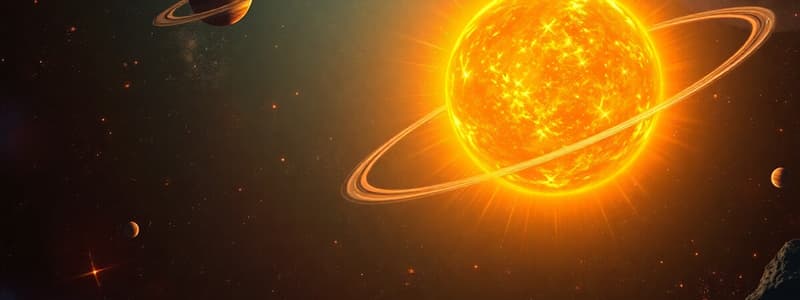Podcast
Questions and Answers
What is the central object in the solar system?
What is the central object in the solar system?
- The Sun (correct)
- The Earth
- A distant galaxy
- The Moon
Which of these is considered a dwarf planet in our solar system?
Which of these is considered a dwarf planet in our solar system?
- Pluto (correct)
- Jupiter
- Mars
- Venus
What primarily dictates the orbit of planets in the solar system?
What primarily dictates the orbit of planets in the solar system?
- Their magnetic fields
- The gravity of Neptune
- Their size
- The Sun's gravity (correct)
Which statement best describes the asteroid belt's location?
Which statement best describes the asteroid belt's location?
Which of these celestial bodies is known for its prominent ring system?
Which of these celestial bodies is known for its prominent ring system?
Flashcards
Solar System
Solar System
The collection of the Sun and celestial bodies orbiting it, including planets, moons, asteroids, and comets.
Planets
Planets
Large celestial bodies that orbit a star; in our solar system, there are eight major planets.
Moons
Moons
Natural satellites that orbit planets; some planets have many, others have none.
Asteroids
Asteroids
Signup and view all the flashcards
Comets
Comets
Signup and view all the flashcards
Study Notes
Introduction to the Solar System
- The solar system is the gravitationally bound system comprising the Sun and the objects that orbit it, including planets, dwarf planets, moons, asteroids, comets, and other debris.
- Our solar system is located in the Milky Way galaxy, one of billions of galaxies in the universe.
The Sun
- The Sun is a star, a massive ball of hot plasma, primarily composed of hydrogen and helium.
- It is the central and most massive object in our solar system, holding all other objects gravitationally in orbit.
- Nuclear fusion reactions within the Sun's core generate immense energy that powers all life on Earth and other happenings within the solar system.
- The Sun's energy is released as light and heat, vital for sustaining life on Earth and other planets.
- The Sun's diameter is approximately 865,000 miles (1.39 million kilometers).
Inner Planets
-
The inner, terrestrial planets are closer to the Sun and are smaller and denser than the outer planets.
-
They are primarily composed of rock and metal.
-
Mercury, Venus, Earth, and Mars are the four inner planets.
- Mercury: The smallest and closest planet to the Sun. It experiences extreme temperature variations due to its lack of an atmosphere.
- Venus: The hottest planet due to its dense atmosphere, primarily composed of carbon dioxide. The atmosphere traps heat through a greenhouse effect.
- Earth: The only known planet to support life. It has a protective atmosphere containing oxygen and water in liquid form.
- Mars: Often called the "Red Planet" because of its reddish appearance. It has evidence of past water activity and is a target of ongoing exploration by space missions.
Outer Planets
-
The outer planets are larger and less dense than the inner planets.
-
They are primarily composed of gases like hydrogen and helium.
-
Jupiter, Saturn, Uranus, and Neptune are the four outer planets.
- Jupiter: The largest planet in our solar system, with a powerful magnetic field and many moons.
- Saturn: Known for its spectacular ring system, composed of ice and rock particles.
- Uranus: Unique for its tilted axis, rotating on its side.
- Neptune: The furthest planet from the Sun and known for its strong winds and storms.
Dwarf Planets and Other Objects
- Dwarf planets, like Pluto, Ceres, and Eris, are smaller than the planets but larger than asteroids.
- They orbit the Sun but do not clear their orbital neighborhood of other objects.
- Asteroids are rocky, airless bodies that orbit the Sun.
- Comets are icy bodies that release gas and dust as they approach the Sun, forming tails.
- Moons (natural satellites) orbit planets or dwarf planets.
Formation of the Solar System
- The current prevailing theory suggests that the solar system formed from a giant cloud of gas and dust called the solar nebula.
- Gravity caused the nebula to collapse, forming a rotating disk.
- The center of the disk became the Sun, and the remaining material formed the planets and other objects through accretion.
Distances within the Solar System
- Distances within the solar system are vast and are typically measured in astronomical units (AU).
- One AU is the average distance between the Earth and the Sun.
Important Concepts
- Orbit: The path a celestial body follows around another body due to gravity.
- Gravity: The force that holds the solar system together and keeps planets and other objects in their orbits.
- Accretion: The process by which small particles accumulate to form larger objects.
Studying That Suits You
Use AI to generate personalized quizzes and flashcards to suit your learning preferences.




